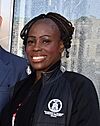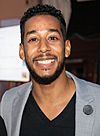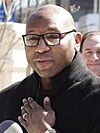Borough president facts for kids
The borough presidents are important leaders in each of New York City's five main areas, called boroughs. These leaders help guide their borough and speak up for its needs.
For a long time, borough presidents had a lot of power in their areas. They were also part of a powerful group called the New York City Board of Estimate. This group made big decisions about the city's money and how land was used. But in 1990, the Board of Estimate was stopped, and the borough presidents lost many of their old powers.
Today, borough presidents still have important jobs. They give advice to the Mayor of New York City and share their thoughts on how land should be used in their borough. They also speak up for their borough's needs when the city plans its yearly budget. They get to choose some officials and members for local community groups. They also serve on different city boards and committees because of their job. Mostly, they act as a voice for their borough, talking to city agencies, the City Council, the New York State government, and even businesses. Their roles are written down in the city's main rule book, the New York City Charter.
Contents
A Look Back: How the Job Started
On January 1, 1898, the five boroughs of Manhattan, the Bronx, Brooklyn, Queens, and Staten Island all joined together to form the single, big city of New York. Before this, these areas had their own town and county governments. When they joined, these older governments were dissolved. Their powers were then given to the new city and its boroughs.
The borough president jobs were created to handle many of the tasks that the old mayors and county leaders used to do. For example, Manhattan and the Bronx were once part of New York County. Brooklyn was Kings County. The borough of Queens was part of Queens County, and Staten Island was Richmond County. The new boroughs took over most county duties, but they didn't completely replace the counties themselves.

Over time, some parts of these areas changed. For instance, in 1899, the eastern part of Queens County became a new area called Nassau County. Later, in 1914, Bronx County was created from a part of New York County. This meant that New York County then became the same as the Borough of Manhattan. In 1975, the name of the borough of Richmond was officially changed to Staten Island.
When the city first formed, borough presidents were elected for four-year terms, just like the mayor. They earned a salary, and they could hire their own staff. This hiring power quickly became a way for them to give jobs to friends or supporters, which is sometimes called "political patronage." Borough presidents also had a vote on the powerful New York City Board of Estimate. This board made big decisions about the city's money and how land was used.
The jobs of borough presidents were created to help people keep their "local pride" and connection to their old towns after everything joined together.
In 1902, when the city created a single group of lawmakers called the Board of Aldermen, each borough president also got a seat on this board.
Borough presidents slowly gained more power. They helped decide more parts of the city budget and had control over land use, city contracts, and special permits. Sometimes, political parties would reward loyal public servants by helping them become borough president. While some borough presidents served for many years, the job was also sometimes a stepping stone to other important positions, like becoming a judge or even mayor, as Robert F. Wagner, Jr. did.
Big Changes: Losing Power
On March 22, 1989, a very important decision was made by the Supreme Court of the United States. The court ruled that the New York City Board of Estimate was unfair and against the law. This was because Brooklyn, which had many more people (2.2 million at the time), had the same number of votes on the board as Staten Island, which had far fewer people (350,000). This went against the idea of "one person, one vote," which means everyone's vote should count equally.
Because of this ruling, the city had to change its government. In November 1989, New Yorkers voted to approve these changes. A month later, the changes were also approved by the United States Department of Justice.
After these changes, the borough presidents kept their jobs, but with much less power. The mayor and City Council became responsible for the borough budgets. Today, borough presidents have a smaller budget they can use for projects in their boroughs. Their last major power, which was to appoint members to the city's Board of Education, was removed in 2002 when the Board of Education became the Department of Education.
What Do Borough Presidents Do Today?
Even with less power, borough presidents still make some important appointments. They each appoint one member to the New York City Planning Commission, which helps plan how the city grows. They also appoint two members to the New York City Panel for Educational Policy, which helps make decisions about schools.
While they are often seen as ceremonial leaders, their official duties include:
- Giving advice to the mayor on issues in their borough.
- Commenting on plans for how land is used in their borough.
- Speaking up for their borough's needs during the city's yearly budget process.
- Appointing members to local community boards.
- Leading their borough's boards.
- Serving on various other city boards and committees because of their job.
They also act as advocates for their boroughs, talking to different city agencies, the City Council, the New York State government, and even private businesses.
Borough presidents are chosen by voters for four-year terms. They can serve for a maximum of two terms in a row, which is eight years.
Borough presidents also have a say in how land use is decided through a process called the Uniform Land Use Review Procedure (ULURP). They do this by appointing members to community boards, who then vote on land use applications. Groups that help businesses grow in the borough often work closely with the borough president.
Who Are the Current Borough Presidents?
The current borough presidents were elected or re-elected in 2021:
| Borough | President | Image | Party | Term |
|---|---|---|---|---|
| Vanessa Gibson |  |
Democratic | January 1, 2022 – present | |
| Antonio Reynoso |  |
Democratic | January 1, 2022 – present | |
| Mark Levine |  |
Democratic | January 1, 2022 – present | |
| Donovan Richards |  |
Democratic | December 2, 2020 – present | |
| Staten Island | Vito Fossella |  |
Republican | January 1, 2022 – present |
How Borough Boards Work
Each of New York City's five boroughs has a borough board. These boards are made up of the borough president, City Council members from that borough, and the leader of each community board in the borough.
Borough boards can:
- Hold public or private meetings.
- Create plans for land use and make recommendations.
- Help solve disagreements between different community districts.
- Submit ideas for what their borough needs in terms of money and projects.
- Check on how well city projects are doing and how good city services are.
- Think about other needs of the borough.
What Are Community Boards?
Each of the fifty-nine community districts in New York City has a community board. These boards have up to 50 volunteer members. The borough president appoints these members, with half of them nominated by City Council members who represent that district.
Community boards:
- Give advice on land use and zoning rules.
- Take part in the city's budget process.
- Help address issues with city services in their district.
It's important to remember that community boards only give advice. They do not have the power to make or enforce laws themselves.
More to Explore
- Government of New York City
- List of borough presidents of New York City
See also
 In Spanish: Presidente del borough para niños
In Spanish: Presidente del borough para niños

